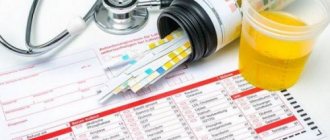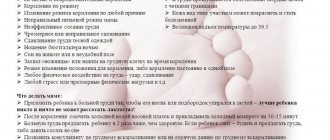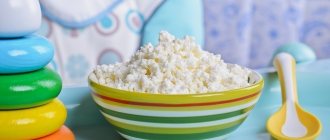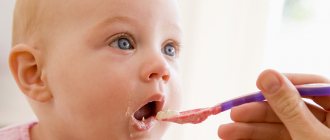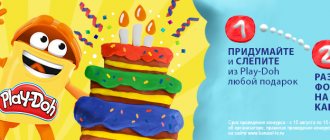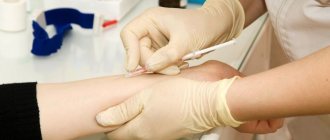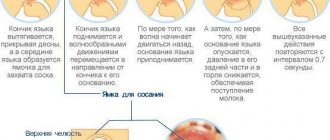General rules
Acetonemic conditions occur in children with infectious diseases, diseases of the digestive system or in stressful situations.
They are provoked by excessive physical and mental stress and dietary errors. When the need for glucose as an energy source exceeds its supply, glycogen stores in the liver are converted into glucose and are quickly depleted. Nervous and active children do not have enough glycogen reserves for high metabolic demands and fats are included in the exchange, and when they break down, ketone bodies are formed. Due to the imperfection of the enzyme system in children (deficiency of the enzyme that metabolizes ketone bodies), their accumulation occurs. Acidosis develops (a shift in the blood to the acidic side) and endogenous intoxication, which is accompanied by bouts of vomiting and weakness. Acetone is excreted in the urine, when breathing in the air, and through the skin of the child. The main complaint is attacks of nausea, vomiting (3-8 times a day), agitation turning into weakness, abdominal pain, smell of acetone from the mouth, and sometimes fever.
Acetone syndrome is not a disease, but a statement of the fact that the body’s glucose reserves have been exhausted. Therefore, the only treatment method is sweet drinks and proper nutrition after an attack.
The diet for acetone syndrome in children should contain:
- Easily digestible carbohydrates and consist of sweet cereals, curds, fruit purees, compotes and sweet jelly.
- Sufficient amount of fluid (1-1.5 liters per day).
- Products that support the alkaline reaction of urine: lemon juice, prunes, dates, figs, sweet berries and fruits, beets, carrots. Eggs, meat, fish, wheat bread cause acidification and are introduced only for 2-3 days. You should limit sour fruits (kiwi, rosehip decoction, currants).
For children subject to frequent acetonemic conditions, long intervals between meals are unacceptable. You need to know that this condition can be caused by any infection or cold, so for acute respiratory infections, the diet should be light and contain mainly simple carbohydrates.
What foods can you eat after an attack? Immediately after vomiting stops, you can give a sweet drink (tea, compote, juice, glucose solution). When the child is able to eat, and this may be on the second day, a gentle diet is prescribed, rich in carbohydrates and food portions should be small:
- liquid porridges (buckwheat, rice, corn, oatmeal) without sugar and salt;
- fruit mousses and jelly;
- biscuits;
- baked apple;
- vegetables and sweet fruits.
From the third or fourth day:
- vegetable soups;
- skim cheese;
- meat soufflé, turkey, rabbit, sea fish dishes;
- chicken eggs (omelet, soft-boiled);
- fermented milk products without preservatives and dyes.
Table No. 1 is prescribed for a period of at least a month . Nutrition should be moderately gentle on the stomach (exclude mechanical, chemical and temperature aggression). Dishes should not irritate the mucous membrane of the upper gastrointestinal tract and should not contain indigestible foods (turnips, radishes, asparagus, beans, radishes, peas). The food should be warm.
The diet for acetone in the urine in children involves a split diet (up to 6 times a day), in small portions. It is important that the break between meals is no more than 3 hours. If the child refuses to eat, let him drink a glass of fruit juice or compote with honey, eat any sweet fruits, dried fruits (prunes, dates, dried apricots) or cookies. But after a while you need to offer a full lunch or dinner again.
After vomiting, the mucous membrane of the stomach and esophagus suffers to a greater or lesser extent, so it will be better if the food is liquid and mushy. If you offer dishes with a dense consistency, then it is better to puree them. It is also worth mentioning that dishes are prepared boiled (steamed), they can be baked, but frying is excluded.
Since increased acetone in the urine is also associated with impaired fat metabolism and consumption of fatty foods, low-fat dairy and meat products should be present in the diet. It is unacceptable to consume fried foods, fatty meat broths, sour cream, smoked meats, and canned food.
The appearance of acetone in the urine during pregnancy is quite common, so women are constantly asked to take urine tests for ketone bodies. The cause of increased acetone during pregnancy may be any pathology or poor nutrition. But most often - a severe form of toxicosis with vomiting and lack of appetite. When vomiting, fluid and electrolytes are lost, and during hunger, proteins and fats are included in the metabolism, the breakdown product of which is ketone bodies (acetone), found in the urine. An unhealthy diet, in which fatty foods and large amounts of meat are consumed, can cause the appearance of acetone in the urine. It should be noted that excessive “infatuation” with sweets can also be accompanied by such disorders.
If there is acetone in the urine of pregnant women associated with toxicosis, a drinking regime is prescribed - drinking alkaline mineral water (Borjomi) in small sips so as not to provoke vomiting. You need to drink up to 1.5 liters of liquid per day. When nausea and vomiting disappear, you need to start eating small portions of salads, fruits, vegetable soups, juices, cereals. It is not recommended to fast, which may worsen the condition again.
If in the early stages the appearance of acetone in the urine of pregnant women may be the result of toxicosis, then in the later stages one can think about the presence of gestational diabetes mellitus . This means that the woman will have to undergo a more thorough examination by an endocrinologist.
Journal "Child's Health" 3 (30) 2011
In childhood, special attention is required to functional disorders of the digestive organs associated with impaired neuroendocrine regulation, as a possible basis for the formation of organic pathology in the future. Such diseases include acetonemic syndrome, which has been widely discussed in recent years in the literature. In foreign literature, as well as in ICD-10, this syndrome is not identified as a separate nosological unit, but in the XVIII section of ICD-10, under the heading R11, cyclic vomiting syndrome (CVS) is presented. Pathogenetically and clinically, these two syndromes are very close, which, apparently, will subsequently contribute to their convergence [3, 5, 6].
Acetonemic syndrome is understood as a set of symptoms caused by an increased content in the blood of products of incomplete oxidation of fatty acids formed during the breakdown of ketogenic amino acids: acetone, acetoacetic acid and g-hydroxybutyric acid [2, 3]. There are primary and secondary acetonemic syndromes. In children, a number of diseases are accompanied by hyperketonemia. These, in particular, include diabetes mellitus, renal glucosuria, glycogenosis, thyrotoxicosis, infectious toxicosis, toxic liver damage, hyperinsulinism, traumatic brain injury, Itsenko-Cushing disease, leukemia, hemolytic anemia. The clinical picture of acetonemic syndrome in such cases is determined by the underlying disease, and ketonemia and manifestations of typical or atypical gout should be considered as secondary acetonemic syndrome.
Primary acetonemic syndrome in children is considered a manifest form of uric acid diathesis or neuroarthritic anomaly of constitution (NAAC) and refers to dismetabolic genetically determined pathological conditions. The disease is characterized by permanent hyperuricemia, increased excitability of the nervous system and periodic metabolic crises with hypoglycemic ketoacidosis, hyperketonemia, ketonuria, and dyselectrolythemia. Enzymopathy plays a certain role in the genesis of the disease, which results in insufficient utilization of carbohydrates and fats from food. Primary acetone syndrome occurs in 4–6% of children in the population and in 50% of children with NAA, usually between the ages of 1 and 12 years. Very often (in almost 90% of cases) multiple vomiting is observed in the structure of crises, which is defined as acetonemic [2–4].
Children with NAAK are characterized by the following features:
- increased excitability and rapid exhaustion of the nervous system at all levels of reception with the presence of a dominant focus of stagnant excitation in the hypothalamic-diencephalic region;
- deficiency of liver enzymes (glucose-6-phosphatase, hypoxanthine-guanine-phosphoribosylpyrophosphate synthetase);
- low acetylating ability of acetyl coenzyme A due to deficiency of oxalic acid;
— violation of the mechanism of reuse of uric and lactic acids;
- disorders of fat and carbohydrate metabolism;
- disruption of endocrine regulation of metabolism.
According to classical ideas, such children are characterized by increased excitability, emotional lability, and sleep disturbances. By the end of the first year of life, they usually lag significantly behind their peers in body weight. Neuropsychic development, on the contrary, is ahead of age norms. Starting from 2–3 years of age, equivalents of gouty attacks and crises are noted in the form of transient night pain in the joints, abdominal pain of a spastic nature, biliary and gastric dyskinesias, migraines, and acetonemic crises. One of the typical manifestations of NAAC is saluria with predominant uraturia. Acetonemic crises in most children stop after 10–12 years. However, there remains a high probability of developing pathological conditions such as gouty crises, dysmetabolic nephropathy, cholepathy, vegetative-vascular dystonia of the hypertensive type, and arterial hypertension [2].
Both during an acetonemic crisis and during an attack of cyclic vomiting, repeated indomitable vomiting is observed. The pathogenesis of these conditions is largely similar.
As a rule, with cyclic vomiting syndrome, nausea, vomiting mixed with bile, abdominal pain, headache, discomfort during movement, and increased sensitivity to light and noise are noted, but this is not typical for all patients. In addition, some patients have fever, pallor, excessive sweating, diarrhea, dehydration, hypersalivation, and high blood pressure [5, 6].
Currently, cyclic vomiting syndrome is considered as a polyetiological disease, which is based on disorders of the hypothalamic-pituitary-adrenal system (increased secretion of corticotropin-releasing factor) and autonomic dysfunction (sympathicotonia). Numerous studies have shown that infectious, psychological, and physical stress can cause vomiting. Before the onset of vomiting, there is a significant increase in ACTH and corticotropin levels.
The concept of cyclic vomiting syndrome as a mitochondrial pathology is promising [5, 6, 8]. Since mitochondria are, figuratively speaking, the energy stations of the cell, energy metabolism is disrupted in this disease. Under conditions of stress and hypoxia, energy metabolism is disrupted with a predominance of faster anaerobic glycolysis, but only 2 ATP molecules are formed, whereas under aerobic glycolysis - 38. Energy deficiency occurs.
Such disorders are closely related to disorders of purine metabolism, since energy in the body is stored in the form of nucleotides, among which adenine and guanine are purines, and they are metabolized to uric acid, and thymine, cytosine and uracil are pyrimidines and are metabolized to form ketone bodies - ammonia and beta-isobutyric acid [2, 5]. These ideas pathogenetically bring together the syndrome of cyclic vomiting and acetonemic syndrome, and also explain the need and possible ways of metabolic correction.
Two functionally different structures of the medulla oblongata are responsible for the act of vomiting - the vomiting center in the lateral reticular formation and the chemoreceptor trigger zone in the rhomboid fossa at the bottom of the fourth ventricle. Therefore, there are two mechanisms of nausea and vomiting. The first is associated with afferent impulses from the digestive organs directly to the vomiting center. The second is due to stimulation of the trigger zone by such mediators as serotonin, angiotensin II, vasoactive intestinal polypeptide, dopamine, antidiuretic hormone, etc., as well as a number of drugs, endotoxins of gram-positive bacteria.
Through the autonomic hypothalamic centers, under the influence of stress, fat-mobilizing hormones (somatotropin, lipotropin) are activated, which leads to excessive lipolysis and ketogenesis, and a large number of ketone bodies are formed.
Substantiating the diagnosis of cyclic acetonemic vomiting syndrome requires a careful review of the history, physical examination and laboratory findings to exclude other diseases that may cause vomiting similar to CVS.
Treatment
Programs for relieving the acetonemic crisis are well known. In case of initial symptoms, it is advisable to clean and rinse the intestines with a 1–2% solution of sodium bicarbonate and give the child every 10–15 minutes sweet tea with lemon, non-carbonated alkaline mineral water (Luzhanskaya, Borjomi, etc.), 1–2% solution of sodium bicarbonate, combined oral rehydration solutions. Food should contain easily digestible carbohydrates and a minimum amount of fat (liquid semolina or oatmeal, mashed potatoes, milk, baked apples). Drug therapy includes antispasmodics and enterosorbents. Due to stool retention, the use of diosmectite is not advisable.
In the event of the development of an acetonemic crisis, accompanied by repeated or uncontrollable vomiting, treatment is aimed at correcting acidosis, ketosis, dehydration and dyselectrolythemia. With increasing exicosis, infusion therapy is indicated. As infusion solutions, 5-10% glucose solution with insulin and crystalloid sodium-containing solutions (0.9% sodium chloride solution, Ringer's solution) are used in a ratio of 1: 1 or 2: 1, taking into account the indicators of water-electrolyte metabolism. The total volume of fluid administered is 50–60 ml/kg per day. If the child drinks willingly, parenteral administration of infusion solutions can be completely or partially replaced by oral rehydration, which is carried out with combined drugs.
Treatment of acetonemic syndrome during the interictal period is aimed at preventing relapses of acetonemic crises and is carried out in courses at least 2 times a year, usually in spring and autumn. Hepatoprotectors can be prescribed; in case of frequent and severe acetonemic crises, derivatives of ursodeoxycholic acid are prescribed for the purpose of prevention.
Regime restrictions in children with NAA must be observed at all times: sufficient time in the fresh air, regular, strictly dosed physical activity, water procedures (swimming, contrast shower, dousing), sufficient sleep (at least 8 hours). Sun exposure should be avoided. It is advisable to reduce the time spent watching TV and working with the computer. The diet should be dominated by lactic acid products, cereals, fresh vegetables, fruits, and boiled lean meats.
It is necessary to limit the consumption of foods rich in purines and ketogenic amino acids. The meat of young animals, fatty meats, offal, smoked meats, and concentrated broths are excluded from the diet. Sorrel, cauliflower, tomatoes, citrus fruits, and drinks containing caffeine are contraindicated [3, 4].
Despite the successful use of pathogenetically based differentiated regimens in the treatment of acetonemic syndrome in children, this problem currently remains relevant. Along with rehydration therapy, an important link in the treatment of the syndrome is the correction of metabolic disorders. From our point of view, the use of the drug Stimol® (Biocodex, France) is justified for this purpose.
Recently, positive clinical experience has been accumulated in the use of Stimol® for the treatment of primary acetonemic syndrome both during an attack and in the interictal period [1–3].
The purpose of this study was to study the effectiveness of Stimol® in the complex therapy of acetone syndrome in children during a crisis period.
Materials and methods
The metabolic drug Stimol® contains two amino acids - malate and citrulline, which activate the mechanism of energy production at the cellular level. Normally, they are always present in the human body and are catalysts for vital metabolic processes. Malate is malic acid, which stimulates the Krebs cycle, takes part in the process of gluconeogenesis, reduces lactate levels in the blood and tissues, prevents lactic acidosis, promotes ATP synthesis and is the main supplier of energy for metabolic processes. Citrulline is one of the amino acids that is part of the urea cycle. Citrulline activates the formation and removal of ammonia compounds from the body. Thus, Stimol® ensures the utilization of lactate and ammonia and promotes the formation of energy, transferring the cell to another energy level.
Studies to evaluate the effectiveness of the drug Stimol® in primary acetonemic syndrome in children were carried out on the basis of the gastroenterological department of the children's clinical hospital No. 2 in Dnepropetrovsk. We examined 37 children with acetonemic vomiting syndrome: 18 girls and 19 boys aged from 3 to 12 years (average age 5.5 years), 10 of whom formed the comparison group.
In the main group, against the background of basic therapy, Stimol® was prescribed, 1/2 sachet for children from 3 to 6 years old and 1 sachet for children over 6 years old, 3 times a day, dissolving the contents in 100 ml of warm water. The drug was administered in small portions from the first hours after hospitalization to avoid provoking the gag reflex. Children from the comparison group received only basic therapy - diet, parenteral and oral rehydration, detoxification therapy, enterosorption, and according to indications - antibacterial agents, antispasmodics, enzyme preparations.
The dynamics of clinical manifestations in children in both groups were assessed using a specially developed scoring scale depending on the severity of the main symptoms. The following indicators were assessed: signs of intoxication, frequency of vomiting, severity of abdominal pain, dyspeptic symptoms, as well as the degree of ketonuria in points from 0 to 4. The severity of clinical manifestations based on the sum of points was tracked during the first 7 days of treatment. The dynamics of the severity of ketonuria under the influence of prescribed therapy during the first day was monitored every three hours. For this purpose, test strips were used to quickly detect ketones in urine. The determination principle is based on the reaction of acetoacetic acid with sodium nitroprusside, and the color of the strip changes from beige to red-violet. The results were assessed visually by comparing the reagent strip with a color scale applied to the container. The degree of acetonuria was determined from + to ++++ (or in points from 1 to 4).
Results and its discussion
It was found that most often attacks of acetonemic vomiting were provoked by a violation of diet (16.2%), infectious disease (29.7%), exacerbation of chronic pathology of the gastrointestinal tract (21.6%), psychological, often positive, stress (32, 4 %). Background pathologies were functional dyspepsia (8.1%), irritable bowel syndrome (5.4%), biliary dyskinesia (83.8%), chronic cholecystocholangitis (5.4%), pancreatopathies (29.6%), food allergies (18.9%), autonomic dysfunction (54%). In most cases, a burdened perinatal history was revealed (pathology of pregnancy and childbirth, traumatic and hypoxic damage to the central nervous system). The family history was burdened by the presence of chronic gastrointestinal diseases, cholelithiasis and urolithiasis, and hypertension in close relatives.
Upon admission to the hospital, the general condition of all patients was severe due to dehydration and symptoms of intoxication.
The clinic was dominated by abdominal pain, anorexia, lethargy, nausea, repeated vomiting, increased body temperature, and tachycardia. In 100% of children, the urine reaction to acetone was positive. Uraturia was detected in 29.6% of children, oxaluria in 21.6%, the level of urine diastase and blood amylase in the examined children remained normal. Hypoglycemia was detected in 3 patients, hypochromic anemia - in 16.2%, leukocytosis and neutrophilia - in 13.5%, lymphocytosis - in 40.5%. The levels of urea, creatinine, and cholesterol in all children were within normal limits. According to coprogram data, functional pancreatic insufficiency was revealed in 100% of children (steatorrhea, amilorrhea from ++ to +++), according to ultrasound examination - enlargement, granularity, increased echogenicity of the pancreas in 29.6%, pronounced flatulence attracted attention intestines in 48.6% of patients.
Taking into account the role of energy metabolism disorders in the development of acetone syndrome, citrulline malate was justifiably included in treatment complexes. This is due to its detoxification (improvement of the cytochrome oxidase system, inactivation of ammonium, lactate), antihypoxic (stimulation of the Krebs cycle, switching glucose utilization to the aerobic pathway), antiacidotic (acceleration of lactate utilization) properties.
Under the influence of therapy, there was a rapid improvement in the children's condition due to regression of the main clinical manifestations (Table 1). It should be emphasized that from the very beginning of therapy, the rate of their reduction was significantly higher in the main group.
The assessment of the child's condition in points upon admission in the main and control groups was approximately the same and averaged 9.18. However, already on the second day of therapy using Stimol®, the severity of clinical manifestations was 5.64 points, while in the control group it was 6.08. On the third day in the main group - 4.09 points, in the comparison group - 4.86 points (P < 0.05). The rate of reduction of the main symptoms of the disease indicates the high sensitivity of patients to the ongoing pathogenetic therapy (Fig. 1). The inclusion of Stimol® in the treatment of acetonemic syndrome during the attack period made it possible to achieve a more rapid regression of the main symptoms by the 3rd–4th day of the disease, depending on the severity of the symptoms of the disease upon admission. By the seventh day, the condition of the patients in both groups did not differ significantly due to the complete regression of the main pathological manifestations of the disease in almost all patients.
Considering that the greatest differences in the dynamics of pathological symptoms were observed precisely on the first day of the disease, we studied the severity of ketonuria in children of the main and control groups every 3 hours. Rapid positive dynamics were demonstrated in the main group. Thus, within 3 hours from the start of therapy using Stimol®, the severity of ketonuria decreased in 75% of patients, and after 12 hours this symptom was completely relieved in 50% of patients. In the control group, the dynamics were significantly less. After 3 hours - practically no changes; after 12 hours, a decrease, but not stopping of this indicator was achieved only in 20% of patients. The dynamics of the severity of acetonuria in the main and control groups during the first day from the start of therapy is shown in Fig. 2.
Thus, the advantage of including citrulline malate in treatment complexes for acetonemic syndrome in children was the rapid relief of the main symptoms of the disease, especially the rapid relief of acetonuria. Thus, after 24 hours from the start of therapy, in half of the patients, acetone was no longer detected in the urine; in the remaining children, it was possible to reduce the severity of this symptom. We noted good tolerability of the drug in all patients and the absence of side effects.
The results obtained indicate the effectiveness of the drug Stimol® in the complex therapy of primary acetonemic syndrome during the attack period. In addition, taking into account the metabolic characteristics of children with this disease and the mechanisms of action of the drug, treatment with Stimol® is also indicated during the interictal period in spring and autumn, 1/2–1 sachet, depending on age, 2 times a day for 2–3 weeks to prevent relapse. All children in the control group were discharged with recommendations to extend treatment with Stimol® for up to 14 days and, in the interictal period, to conduct a repeated prophylactic course of treatment with Stimol® for 14 days in age-appropriate dosages. The design of this study did not include follow-up observation, which seems relevant in the future. Preliminary results coincide with literature data [1, 2], indicating that continued treatment with Stimol® for up to 14 days and a repeat course in the interictal period allows for the prevention of relapse. The maximum observation period was 6 months; during this time, children receiving Stimol® did not apply for repeated acetonemic crises; in the control group there was 1 case of relapse out of 10.
conclusions
1. In case of acetone syndrome in children, it is pathogenetically justified to include the metabolic drug Stimol® in the treatment complexes.
2. Ketonuria, as one of the important markers of metabolic disorders in acetonemic syndrome, can be stopped in half of sick children within the first day from the start of Stimol® therapy.
3. The effectiveness of Stimol® is evidenced by a more rapid regression of the main clinical manifestations of the disease - nausea, vomiting, anorexia, abdominal pain syndrome.
4. The drug is well tolerated and has no side effects.
5. Indicators of the effectiveness of therapy using Stimol®, the rate of onset of the therapeutic effect and the safety of the drug allow us to recommend Stimol® in the complex treatment of acetonemic syndrome in children during the crisis period, as well as its prophylactic administration in the interictal period.
Authorized Products
- Soups made with vegetable broth from well-cooked cereals, vegetables seasoned with an egg-milk mixture, borscht in vegetable broth.
- Porridge (buckwheat, oatmeal, wheat, corn).
- Rabbit and turkey are allowed in the diet first, a little later beef and lean pork are introduced (not daily), sea fish up to three times a week, chicken - once a week. Meat products are used to prepare cutlets, casseroles with vegetables, meatballs with rice, and quenelles.
- Eggs are allowed daily up to one per day.
- Cottage cheese with low fat content.
- Juices with pulp (diluted with water), dried fruit compote, fruit juice.
- Milk is initially limited and given only as an additive to water-based cereals.
- Kefir and yogurts are better than making them yourself from homemade milk. Yogurts with additives and artificial colors are not allowed.
- Fresh vegetables and fruits are introduced gradually, not from the first week. Start taking fruits with heat-treated ones (baked apples and pears, fruit puree, mashed compotes, jelly, jelly). Potatoes, carrots and beets may be present in soups; baked pumpkin and zucchini are allowed.
- Among sweet desserts, jam, honey, caramel, marmalade, marshmallows are allowed, but all in limited quantities.
- Drinks - sweet juices from fruits and berries.
Table of permitted products
| Proteins, g | Fats, g | Carbohydrates, g | Calories, kcal | |
Vegetables and greens | ||||
| eggplant | 1,2 | 0,1 | 4,5 | 24 |
| zucchini | 0,6 | 0,3 | 4,6 | 24 |
| cabbage | 1,8 | 0,1 | 4,7 | 27 |
| broccoli | 3,0 | 0,4 | 5,2 | 28 |
| carrot | 1,3 | 0,1 | 6,9 | 32 |
| cucumbers | 0,8 | 0,1 | 2,8 | 15 |
| salad pepper | 1,3 | 0,0 | 5,3 | 27 |
| iceberg lettuce | 0,9 | 0,1 | 1,8 | 14 |
| pumpkin | 1,3 | 0,3 | 7,7 | 28 |
| dill | 2,5 | 0,5 | 6,3 | 38 |
Fruits | ||||
| apples | 0,4 | 0,4 | 9,8 | 47 |
Nuts and dried fruits | ||||
| raisin | 2,9 | 0,6 | 66,0 | 264 |
| dried figs | 3,1 | 0,8 | 57,9 | 257 |
| dried apricots | 5,2 | 0,3 | 51,0 | 215 |
| dried apricots | 5,0 | 0,4 | 50,6 | 213 |
| prunes | 2,3 | 0,7 | 57,5 | 231 |
Cereals and porridges | ||||
| buckwheat (kernel) | 12,6 | 3,3 | 62,1 | 313 |
| oat groats | 12,3 | 6,1 | 59,5 | 342 |
| pearl barley | 9,3 | 1,1 | 73,7 | 320 |
| rice | 6,7 | 0,7 | 78,9 | 344 |
Flour and pasta | ||||
| pasta | 10,4 | 1,1 | 69,7 | 337 |
| noodles | 12,0 | 3,7 | 60,1 | 322 |
| buckwheat noodles | 14,7 | 0,9 | 70,5 | 348 |
Confectionery | ||||
| jam | 0,3 | 0,2 | 63,0 | 263 |
| jelly | 2,7 | 0,0 | 17,9 | 79 |
| marshmallows | 0,8 | 0,0 | 78,5 | 304 |
| milk candies | 2,7 | 4,3 | 82,3 | 364 |
| fondant candies | 2,2 | 4,6 | 83,6 | 369 |
| fruit and berry marmalade | 0,4 | 0,0 | 76,6 | 293 |
| paste | 0,5 | 0,0 | 80,8 | 310 |
| Maria cookies | 8,7 | 8,8 | 70,9 | 400 |
Raw materials and seasonings | ||||
| honey | 0,8 | 0,0 | 81,5 | 329 |
| sugar | 0,0 | 0,0 | 99,7 | 398 |
Dairy | ||||
| kefir 1.5% | 3,3 | 1,5 | 3,6 | 41 |
| Ryazhenka | 2,8 | 4,0 | 4,2 | 67 |
Cheeses and cottage cheese | ||||
| cottage cheese 1% | 16,3 | 1,0 | 1,3 | 79 |
Meat products | ||||
| beef | 18,9 | 19,4 | 0,0 | 187 |
| rabbit | 21,0 | 8,0 | 0,0 | 156 |
Bird | ||||
| boiled chicken breast | 29,8 | 1,8 | 0,5 | 137 |
| boiled chicken drumstick | 27,0 | 5,6 | 0,0 | 158 |
| boiled turkey fillet | 25,0 | 1,0 | — | 130 |
Eggs | ||||
| soft-boiled chicken eggs | 12,8 | 11,6 | 0,8 | 159 |
Fish and seafood | ||||
| flounder | 16,5 | 1,8 | 0,0 | 83 |
| pollock | 15,9 | 0,9 | 0,0 | 72 |
| cod | 17,7 | 0,7 | — | 78 |
| hake | 16,6 | 2,2 | 0,0 | 86 |
Non-alcoholic drinks | ||||
| mineral water | 0,0 | 0,0 | 0,0 | — |
| green tea | 0,0 | 0,0 | 0,0 | — |
Juices and compotes | ||||
| apricot juice | 0,9 | 0,1 | 9,0 | 38 |
| carrot juice | 1,1 | 0,1 | 6,4 | 28 |
| peach juice | 0,9 | 0,1 | 9,5 | 40 |
| plum juice | 0,8 | 0,0 | 9,6 | 39 |
| tomato juice | 1,1 | 0,2 | 3,8 | 21 |
| pumpkin juice | 0,0 | 0,0 | 9,0 | 38 |
| * data is per 100 g of product | ||||
Fully or partially limited products
- Concentrated meat and fish broths, jellied meat, veal, chicken once a week, duck, goose, liver, herring, fatty pork, kidneys, brains, sausages, canned meat and fish.
- Fatty foods, fish oil, which is easier than animal oil, is absorbed in the intestines.
- Food with additives, preservatives and dyes.
- Millet, pearl barley and barley are more difficult to digest and are not recommended for children with this condition.
- Tomatoes, sorrel, cauliflower, parsley, rhubarb, spinach, which contain large amounts of uric acid, as well as all legumes (beans, lentils, beans, peas, soybeans) and white cabbage, which increase gas formation, and vegetables that irritate the gastrointestinal tract, are excluded from vegetables. (onion garlic).
- Mayonnaise, ketchup, adjika, canned vegetables, tomato and mushroom sauces due to the content of vinegar and preservatives.
- Sour cream, full fat milk and cottage cheese.
- Sour fruits (oranges, kiwi), fruits high in potassium (bananas, apricots, dried apricots, watermelons, melons), since potassium slows down the excretion of ketoacids in the urine.
- Chocolate sweets, cocoa, puff pastry, baked goods, fresh bread.
- Kvass, sweet carbonated drinks.
Table of prohibited products
| Proteins, g | Fats, g | Carbohydrates, g | Calories, kcal | |
Vegetables and greens | ||||
| canned vegetables | 1,5 | 0,2 | 5,5 | 30 |
| swede | 1,2 | 0,1 | 7,7 | 37 |
| peas | 6,0 | 0,0 | 9,0 | 60 |
| cauliflower | 2,5 | 0,3 | 5,4 | 30 |
| bulb onions | 1,4 | 0,0 | 10,4 | 41 |
| chickpeas | 19,0 | 6,0 | 61,0 | 364 |
| parsley | 3,7 | 0,4 | 7,6 | 47 |
| radish | 1,2 | 0,1 | 3,4 | 19 |
| white radish | 1,4 | 0,0 | 4,1 | 21 |
| tomatoes | 0,6 | 0,2 | 4,2 | 20 |
| beans | 7,8 | 0,5 | 21,5 | 123 |
| horseradish | 3,2 | 0,4 | 10,5 | 56 |
| spinach | 2,9 | 0,3 | 2,0 | 22 |
| sorrel | 1,5 | 0,3 | 2,9 | 19 |
Fruits | ||||
| oranges | 0,9 | 0,2 | 8,1 | 36 |
| bananas | 1,5 | 0,2 | 21,8 | 95 |
Mushrooms | ||||
| mushrooms | 3,5 | 2,0 | 2,5 | 30 |
| marinated mushrooms | 2,2 | 0,4 | 0,0 | 20 |
Nuts and dried fruits | ||||
| nuts | 15,0 | 40,0 | 20,0 | 500 |
| almond | 18,6 | 57,7 | 16,2 | 645 |
Snacks | ||||
| potato chips | 5,5 | 30,0 | 53,0 | 520 |
Bakery products | ||||
| buns | 7,9 | 9,4 | 55,5 | 339 |
| Rye bread | 6,6 | 1,2 | 34,2 | 165 |
Confectionery | ||||
| pastry cream | 0,2 | 26,0 | 16,5 | 300 |
| shortbread dough | 6,5 | 21,6 | 49,9 | 403 |
Ice cream | ||||
| ice cream | 3,7 | 6,9 | 22,1 | 189 |
Chocolate | ||||
| chocolate | 5,4 | 35,3 | 56,5 | 544 |
Raw materials and seasonings | ||||
| mustard | 5,7 | 6,4 | 22,0 | 162 |
| ketchup | 1,8 | 1,0 | 22,2 | 93 |
| mayonnaise | 2,4 | 67,0 | 3,9 | 627 |
Dairy | ||||
| milk 4.5% | 3,1 | 4,5 | 4,7 | 72 |
| cream 35% (fat) | 2,5 | 35,0 | 3,0 | 337 |
| whipped cream | 3,2 | 22,2 | 12,5 | 257 |
Meat products | ||||
| fatty pork | 11,4 | 49,3 | 0,0 | 489 |
| salo | 2,4 | 89,0 | 0,0 | 797 |
| bacon | 23,0 | 45,0 | 0,0 | 500 |
Sausages | ||||
| smoked sausage | 9,9 | 63,2 | 0,3 | 608 |
Bird | ||||
| smoked chicken | 27,5 | 8,2 | 0,0 | 184 |
| duck | 16,5 | 61,2 | 0,0 | 346 |
| smoked duck | 19,0 | 28,4 | 0,0 | 337 |
| goose | 16,1 | 33,3 | 0,0 | 364 |
Fish and seafood | ||||
| smoked fish | 26,8 | 9,9 | 0,0 | 196 |
| black caviar | 28,0 | 9,7 | 0,0 | 203 |
| salmon caviar granular | 32,0 | 15,0 | 0,0 | 263 |
| salmon | 19,8 | 6,3 | 0,0 | 142 |
| canned fish | 17,5 | 2,0 | 0,0 | 88 |
| salmon | 21,6 | 6,0 | — | 140 |
| trout | 19,2 | 2,1 | — | 97 |
Oils and fats | ||||
| butter | 0,5 | 82,5 | 0,8 | 748 |
| olive oil | 0,0 | 99,8 | 0,0 | 898 |
| sunflower oil | 0,0 | 99,9 | 0,0 | 899 |
| animal fat | 0,0 | 99,7 | 0,0 | 897 |
| cooking fat | 0,0 | 99,7 | 0,0 | 897 |
Alcoholic drinks | ||||
| vodka | 0,0 | 0,0 | 0,1 | 235 |
| beer | 0,3 | 0,0 | 4,6 | 42 |
Non-alcoholic drinks | ||||
| soda water | 0,0 | 0,0 | 0,0 | — |
| cola | 0,0 | 0,0 | 10,4 | 42 |
| sprite | 0,1 | 0,0 | 7,0 | 29 |
| * data is per 100 g of product | ||||
Menu for children with acetone syndrome (Diet)
When developing a menu, you need to take into account the child’s tastes; you can also notice which foods make him worse, then they are strictly limited. It is impossible to remove fats from the diet at all; they must be limited and replaced by two-thirds with sunflower, olive, and corn oil, and given with salads or boiled potatoes. Fats can be given in combination with carbohydrates. That is, butter with porridge or vegetable stew, sour cream in vegetable soup, fried cutlets with cereal side dishes.
Difficult-to-digest fats (pork, lamb, duck, pastries and cakes) should be completely excluded. You should sharply limit the meat of young animals and birds, offal, sorrel, rhubarb, tomatoes, oranges and bananas. Preference is given to vegetable and dairy foods and cereals. To normalize metabolism, it is good to introduce cottage cheese, fish and oatmeal.
Moderate use of spices (dill, flaxseed, ginger, coriander), which are introduced to stimulate the ripening of an imperfect enzyme system.
| Breakfast |
|
| Lunch |
|
| Dinner |
|
| Afternoon snack |
|
| Dinner |
|
| For the night |
|
| Breakfast |
|
| Lunch |
|
| Dinner |
|
| Afternoon snack |
|
| Dinner |
|
| For the night |
|
| Breakfast |
|
| Lunch |
|
| Dinner |
|
| Afternoon snack |
|
| Dinner |
|
| For the night |
|
What should parents do?
It is important to hold out for 5-6 days, after which the children’s body begins to actively produce enzymes that neutralize ketone bodies, and they are actively excreted by the kidneys. After this, the baby’s condition gradually normalizes. The most important thing during this time is to prevent disruption of the water-salt balance, in other words, dehydration and provide the body with a sufficient amount of glucose.
- First of all, it is necessary to feed the child, constantly replenishing fluid reserves. For high levels of acetone, a pharmaceutical glucose solution is best suited. A drink that is at body temperature is absorbed most quickly. Drink in small sips, so as not to provoke vomiting, every 15-20 minutes.
- You need to offer your baby any sweet drinks that he agrees to, alternating them with liquid glucose and oral rehydration solution (you can buy pharmacy powder or prepare it yourself)
- Do not feed the child, especially if he does not ask. If you really want to eat, offer a couple of spoons of baked apple, but not earlier than 3 hours after the last attack of vomiting.
- If you can’t get your child to drink: he refuses to drink, or every sip ends in vomiting, hospitalization may be necessary - the baby will need an IV.
photo Legion-Media
Recipes
The acetone diet in children is predominantly vegetable and dairy, so breakfast consists of cereals cooked in water or with the addition of milk. You can also give your child cottage cheese or cook omelettes. The first courses are often clear, non-rich soups (vegetable or cereal).
Fish dishes should be given preference and cooked 3 times a week. It can be baked fish, steamed or baked fish cutlets, dumplings, stewed fish with vegetables. You can not be lazy and please your child with healthy desserts, especially since carbohydrates are not limited to: fruit and berry mousses, carrot and pumpkin casseroles with honey and dried fruits, sambuca, fruit and berry souffles.
First meal
Rice soup with carrots
Vegetable broth, rice, carrots, butter.
Boil rice and carrots and puree. Combine with vegetable broth, add salt and oil.
Second courses
Turkey and Zucchini Casserole
Turkey meat, vegetable oil, milk, flour, zucchini, egg, salt.
Pass the boiled meat through a meat grinder, add milk sauce and beaten egg. Mix the minced meat with grated zucchini and add salt. Place on a baking sheet, pour sauce on top and bake.
Dessert
Curd soufflé
Grind the cottage cheese, add milk, sour cream, yolk and semolina. Beat everything in a mixer and finally add the whipped whites into the mixture. The curd mass in the mold is steamed.
For children
Acetone syndrome and the smell of acetone from the mouth is not a disease, but a statement of the fact that the body’s glucose reserves have been exhausted. Therefore, the only treatment method is sweet drinking. In a serious condition and with frequent vomiting, it is not possible to give the child something to drink and his condition worsens. In such cases, hospitalization is suggested and glucose solution is administered intravenously. For mild and moderate crises (“+” or “++”), the child is treated at home. Remember that vomiting should be stopped as quickly as possible, because it leads to dehydration, weakens the immune system and causes an increase in ketone bodies.
For acetone in children, Komarovsky recommends giving glucose tablets or fructose (add to boiled water). In case of illness, stress and stress, you need to give a sweet drink at the first sign.
During the first 12 hours, when a crisis has developed, hunger is prescribed and every 15 minutes you need to give the child alkaline mineral water without gas (Borjomi, Essentuki), 1-2% solution of baking soda, alternating with sweet tea with lemon, glucose from ampoules. Regidron , Orsol , Humana will also help , they restore the electrolyte composition of the blood and contain glucose, so there is no need to administer it additionally.
A cleansing enema with soda (1 teaspoon per glass of water), which can neutralize ketone bodies in the intestines, has a good effect. In addition to these recommendations, Komarovsky advises giving the child the drug Nicotinamide , which regulates glucose metabolism. Take at a dose of 5 mg per kg of child’s weight three times a day (1 ml of 5% solution contains 50 mg). Manifestations of the acetonemic crisis begin to subside on days 2-3.
Measures to prevent these conditions include limiting animal fats and fatty foods. It is undesirable for a child to be in the sun for a long time; he needs to be protected from negative emotions. Moderate physical activity, exposure to air and water procedures are important. This syndrome usually resolves by age 10 or earlier. However, children suffering from acetone syndrome should be observed by an endocrinologist and periodically tested for blood sugar levels.
How to reduce acetone?
To determine the level of acetone, special tests are sold in pharmacies, purchasing which you can find out the result within a few minutes.
In order to assess the child's condition and prescribe treatment, a doctor's examination is required.
To stop the acenomic crisis, you first need to drink plenty of fluids. It is best to feed the child every 10-15 minutes in small portions (1 tablespoon is enough). The main rule is that the more liquid the body absorbs, the faster the child’s acetone will decrease.
See also: Anti-cellulite diet
If a child’s increase in acetone is accompanied by vomiting, it is necessary to dilute him with rehydron and give him additional glucose. In particularly severe cases, hospitalization and IV drips may be required.
Reviews and results
- “... I know what it is - a child has had it more than once. The last time was due to fatty foods (I ate lard for several days). I already know what to do. If acetone is high, immediately take Borjomi or soda solution, glucose from ampoules, enemas with enterosgel. In my experience, Enterosgel removes acetone well, so as soon as I smell acetone, I give it a teaspoon 3 times a day. Then we move on to soups (with water and without oil), potatoes and cereals. Only from the fourth day a little meat and fruit. We were on a diet for 2.5 months”;
- “... There was acetone in the urine and toxicosis was severe. I couldn’t eat or drink anything - everything flew back out. As a result, I lost 9 kg in a month. It was getting worse, so they sent me to the hospital and gave me glucose. I lay there for 4 days and it was dripping all day. After the first dropper I ate! Every day the acetone decreased. At home I followed a diet - vegetables, boiled meat, porridge. I began to feel much better. My friend didn’t bring herself to any state - she tried to drink a lot and didn’t eat fatty foods, everything went away for her without treatment”;
- “... The child developed acetone after a sore throat. We treated ourselves at home: Regidron, Borjomi, tea, decoction of dried apricots and raisins. She gave 2 liters per day (she also gave water at night, every 40 minutes). I did soda microenemas every 3 hours. On the second day there was no vomiting and they ate wheat crackers with rice water; on the 3rd day there was rice porridge with raisins, then kefir and meat. We were on a diet for a month and had to prepare dietary meals separately for the child. I cooked everything in a double boiler and carefully thought through the diet. My daughter recovered quickly from her diet and her appetite is now good.”
Signs of acetone crisis
The appearance in the child’s body of an excess of ketone bodies, which are an intermediate link in energy metabolism. As you know, the main source of energy is glucose, and its excess is partially deposited in the liver in the form of glycogen, and some of the carbohydrates are converted into fat. With a sharp increase in energy costs - physical or mental stress, high temperature, emotional outburst, when glucose consumption increases sharply, glycogen stored in the liver comes to the rescue. Since the child’s body is not yet sufficiently developed and the baby’s liver volume is small, he cannot accumulate a sufficient amount of glucose, and the process of its release from fat deposits begins. However, the breakdown of fat cells occurs with the release of other substances, including those same ketone bodies (one of the components is acetone).
- One of the first signs of ketone bodies in the blood, and then in the urine, is at first a light, and then quite sharp, sweetish odor, reminiscent of both acetone and fruity apple.
- An increase in acetone levels, as a rule, occurs against the background of illness or sudden stress - physical or emotional.
- The appearance of ketone bodies causes weakness in the child
- Severe, sometimes uncontrollable vomiting
- Lack of appetite
Photo: ID Burda

